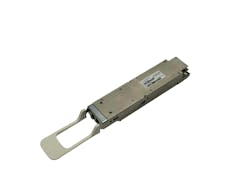View from the top: Alan Lowe, CEO of Lumentum, plots data center, telecom growth prospects
When Lumentum completed the spinoff from JDSU and became an independent, publicly traded company in 2015, CEO Alan Lowe said that the new company had set a new position for itself in the optical industry.
Lumentum manufactures optical and photonic products, enabling optical networking and laser applications. Lumentum optical components and subsystems are part of every telecom, enterprise, and data center network type.
"With a more focused and agile structure, we believe we are well positioned to capitalize on the growth opportunities in both the communications and commercial lasers markets,” Lowe said at the time.
That same spirit continues today. While Lumentum is not immune to the effects of slower service provider spending, Lowe told Lightwave recently that he likes the company’s chances. “Carrier spending is down, but bandwidth requirements are growing,” he said. “Bandwidth will continue to grow.”
He added that another area of growth potential resides with hyperscaler data center providers. “The bandwidth requirements outside the data center are strong, and the industry is going through an air pocket,” he said.
Data center acceleration
One area where Lumentum is seeing great ongoing potential is in the data center market. Lumentum bolstered its data center capabilities through its acquisition of Cloud Light. This acquisition is helping it gain momentum with new data center customers.
When the acquisition was announced, Lumentum said it would accelerate its push into the fastest-growing segments of the multibillion-dollar opportunity for optical modules used in cloud computing data center infrastructure. The company also gained a new 10% customer due to the Cloud Light acquisition. It sees new opportunities with 800 Gbps and 1.6 Tbps.
A large portion of Cloud Light’s over $200 million revenue in the last 12 months was derived from 400G or higher speed transceiver sales. Over half of Cloud Light’s optical transceiver revenue was derived from 800G modules in the most recent quarter.
“In the hyperscale market, the acquisition of CloudLight was to capture more revenue and provide the scale to drive the margins up,” Lowe told attendees during Optica’s Executive Forum at the OFC 2024 trade show. “Now, we have vertical integration that will flow into CloudLight, which should give us those margins.”
Further, acquiring CloudLight can enhance its reach and transceiver revenue opportunities. The company has a broader range of products, including EMLs, VCSELs and silicon photonics.
“We have been a high-margin CL laser provider, and that is less than 10% of the transceiver revenue,” Lowe emphasized during the Optica event. “So, we said our industry's growth is in the high single digits overall with the hyperscalers between what’s going on in the data center and data center interconnect--especially as data centers move further apart, that part of the market is growing 30%. We wanted to be a bigger part of that, which brought us to acquiring Cloud Light.”
The company told analysts and investors during its second-quarter earnings call it expects the market for photonics in cloud networking and data center applications to grow at a compound annual growth rate (CAGR) of about 30%, potentially reaching as high as $16 billion by 2028.
“Datacenter transport is in good shape,” Lowe told Lightwave. “We see an opportunity for innovation and accelerating our position in data center and telecom carrier market segments.”
In particular, Lowe sees data center opportunities on two fronts: internal data centers and connecting data center sites. Data Center Interconnect (DCI) technology connects two or more data centers over short, medium, or long distances using high-speed packet-optical connectivity.
From an internal data center perspective, providers have focused on enhancing speeds while reducing power consumption. “For new data centers, we are designing products for lower power consumption, optical chips and drivers,” Lowe told Lightwave. “Lower power consumption is more important than cost.”
He added, “We view our technology as enabling the industry at the chip level, and a lot has evolved regarding what’s happening with the data center hyperscaler space and what AI drives.”
Emerging 400, 800G opportunities
The vendor also sees more significant demand for 400ZR, 400ZR+ and 800G optical platforms.
According to the fourth quarter 2023 Optical Components Report from research firm Cignal AI, Datacom's optical component revenue, including 800GbE Datacom module shipments, grew for the fourth quarter due to increased demand for optics used in AI clusters.
The research firm said that datacom revenue reached record levels, up 11% YoY, and module shipments grew rapidly in the last two quarters of 2023 as AI demand accelerated. For all of 2023, total Datacom revenue was down -4%, weighed down by poor performance at the start of the year.
“Datacom shipments, especially 800GbE optics, are ramping up fast and shipped units are forecast to reach 8 million in 2024," said Scott Wilkinson, lead analyst for Optical Components at Cignal AI. "Telecom is slowly recovering from a bottom in Q3, but no immediate reversal is in sight.”
Demand for 400ZR and 400ZR+ modules has risen, particularly for data center interconnect (DCI) applications. The ecosystem of transceiver modules, routers, and system software has reached maturity and critical mass for widespread adoption.
The company said that escalating bandwidth demands to support advanced artificial intelligence and machine learning applications are accelerating the need to transition to higher-speed 800 Gbps modules.
In March, Lumentum introduced new enhancements to its 800ZR+ transceivers. These improvements enable the 800ZR+ modules to serve a broader range of applications, including expanded use in metro and regional networks through the ability to interface directly with routers.
Additionally, the enhanced performance modes now make 400ZR+ and 600ZR+ operation suitable for long-haul applications, with OSNR and dispersion tolerance enabling reaches exceeding 2000 km at 400 Gbps.
Lumentum’s 800ZR+ transceivers were recently recognized in the 2024 Lightwave Innovation Review Awards and were demonstrated in a 400 km+ amplified link during the Optical Fiber Communication Conference (OFC).
Telco inventory challenges, opportunities
Lumentum continues to impact the data center with its fiscal second-quarter revenues rising, but like other vendors, it is not immune to the storm of service provider inventory digestion.
The company’s quarterly cloud and networking revenue was up 25% sequentially, driven by solid cloud data center demand and the contribution from the Cloud Light acquisition, but down 25% year-on-year, given broad-based softness across most of our telecom networking product lines due to the continued inventory correction at our network equipment customers.
Lumentum sees the telco inventory correction to continue through fiscal year 2024. “The telco side is coming out of inventory correction,” Lowe told Lightwave. “There’s good bandwidth growth.”
The data center is the only market where Lumentum’s products are finding relevance. Lumentum finds that its coherent transmission products resonate with traditional service providers. It is finding that its coherent transmission products outside the data center resonate in the market. Customers are purchasing its 130 and 200 gigabaud data rate technologies that enable next-generation coherent applications at 800G, 1.2 Tbps and 1.6 Tbps for metro and long-haul applications.
“On the telecom side, our key enablers are the components and chips that go into those components,” Lowe said during the Optica event. “So, we enable many companies to sell ZR transceivers worldwide and make those transceivers. It depends on where our customers want to buy.”
AI’s potential
Lowe is also keenly aware of Artificial Intelligence (AI) like other optical industry leaders.
Lumentum addresses AI on two fronts: pursuing new AI opportunities through its data center customers and using it to enhance its business processes.
To address data demand for AI data centers and the strong traction with transceiver opportunities, Lumentum is expanding its transceiver manufacturing capacity.
A vital part of this expansion is enhancing production lines at its manufacturing facility in Thailand. This facility will manufacture its 1.6 terabit transceivers for multiple customers, providing additional bandwidth for AI workloads while alleviating data bottlenecks with lower power consumption and latency as customers move to 200 Gbps per lane technology.
The company’s staff also uses AI to run its business.
Lowe said using AI has helped Lumentum shorten product development times and enhance business processes. “Our software programmers are using AI to increase their productivity,” he said during the Optica event. “We also use AI to streamline and make our manufacturing lines more efficient.”
He added that “it’s so compelling that as users, we’ll continue to grow the use of AI as a company and that the real driver of why AI is being invested in so much is the use case and the users who are seeing the gains as they turn it on.”
For related articles, visit the Network Design Topic Center.
For more information on high-speed transmission systems and suppliers, visit the Lightwave Buyer’s Guide.
To stay abreast of fiber network deployments, subscribe to Lightwave’s Service Providers and Datacom/Data Center newsletters.
PROFILE
ALAN LOWE
Alan Lowe joined Lumentum as its President and CEO in 2015 when JDSU Communications and Commercial Optical Products business segment became Lumentum. Under his leadership, Lumentum’s business has been transformed by focusing on the customer, investing in innovation, entering new markets such as 3D sensing for consumer mobile devices, and improving operational execution.
Lowe joined JDSU in September 2007 as Senior Vice President of JDSU’s Commercial Lasers group. Earlier, Lowe was Senior Vice President, Customer Solutions at Asyst Technologies, a provider of automated semiconductor and flat panel display fabs. Before this role, he was President and CEO of Read-Rite Corporation, a manufacturer of thin-film recording heads for disk and tape drives.
EDUCATION:
Bachelor’s degree in computer science and business economics from the University of California at Santa Barbara and completed the Stanford Executive Program.
About the Author
Sean Buckley
Sean is responsible for establishing and executing the editorial strategy of Lightwave across its website, email newsletters, events, and other information products.


